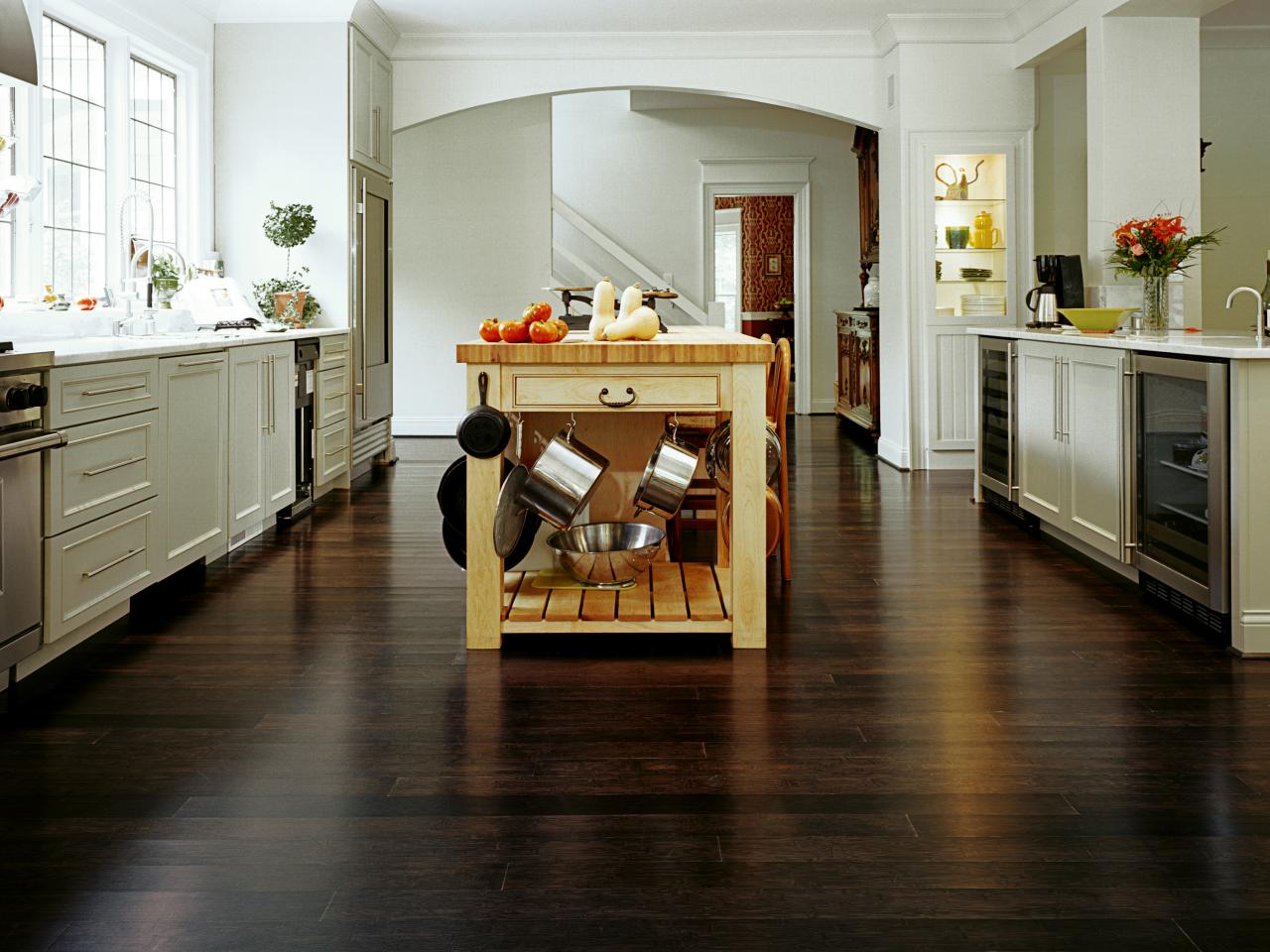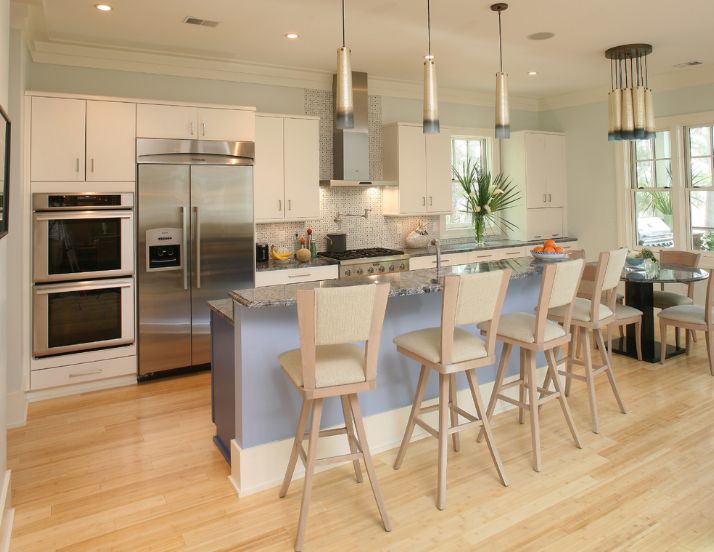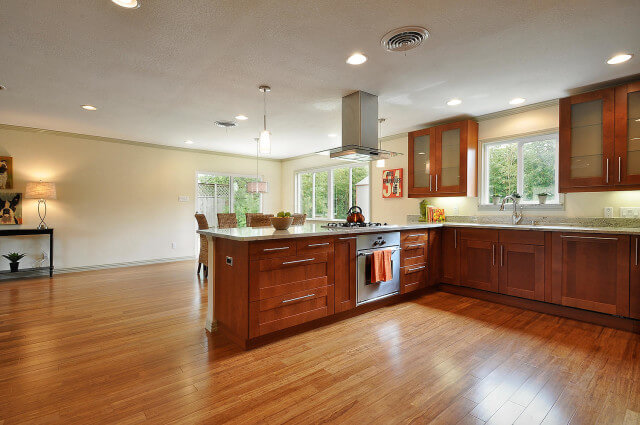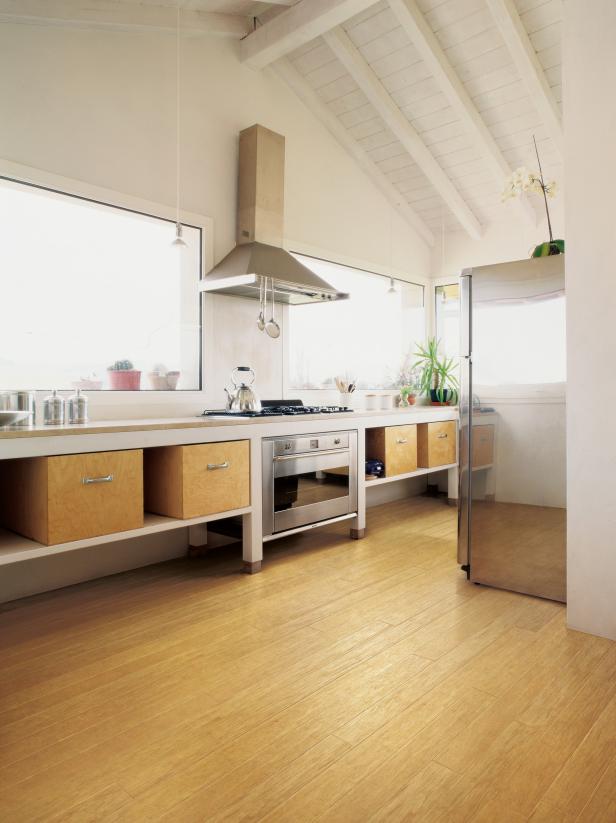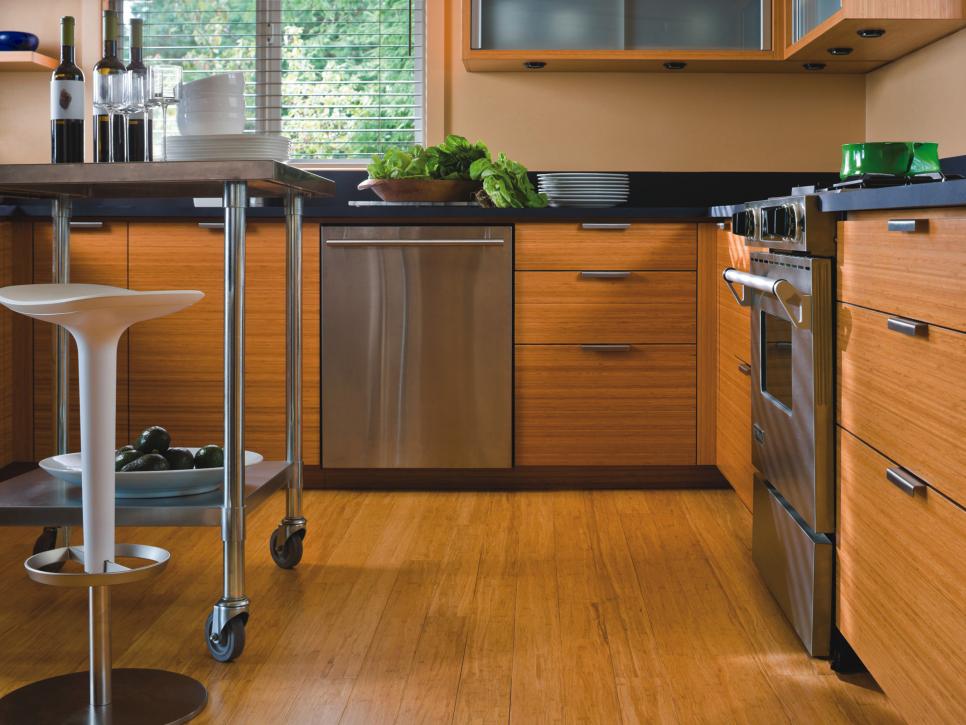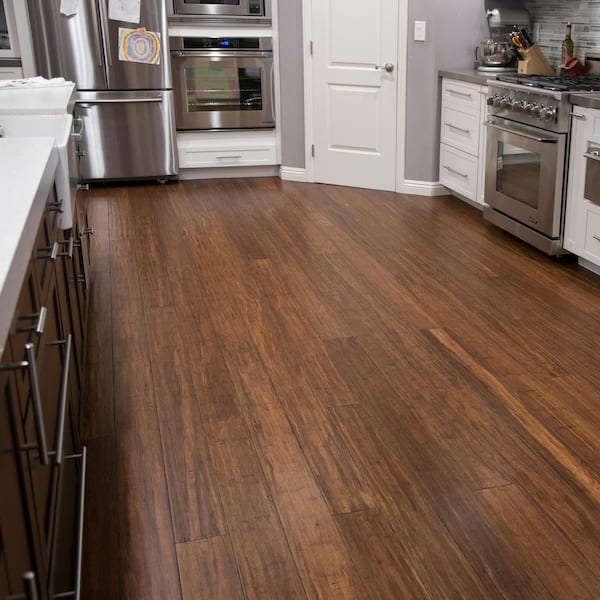Benefits of Choosing Bamboo Flooring
Bamboo flooring has surged in popularity in recent years, and for good reason. It offers numerous benefits, making it an excellent choice for kitchen floors. Here are the key advantages of opting for bamboo flooring in your kitchen:
- Durability and Hardness: Bamboo is exceptionally durable and can withstand heavy foot traffic, which is common in kitchens. Strand-woven bamboo, in particular, is even harder than some types of hardwoods, making it resistant to scratches and dents. This durability ensures that your kitchen floor will look good for many years.
- Aesthetic Appeal: Bamboo flooring brings a unique, natural look to kitchens. Its distinct grain patterns and wide range of colors, from natural blond to deep caramel tones, can complement various kitchen designs and styles. Bamboo’s aesthetic versatility makes it a favorite among interior designers and homeowners alike.
- Eco-Friendliness: Bamboo is an environmentally friendly option because it is a highly renewable resource. Unlike hardwood trees, which can take decades to mature, bamboo can be harvested every 3-5 years. This rapid growth rate makes bamboo a sustainable choice, reducing the environmental impact of your kitchen renovation.
- Affordability: Compared to many hardwood flooring options, bamboo is relatively affordable. It provides a high-end look without the high-end price tag. This cost-effectiveness allows homeowners to achieve the appearance of a luxurious kitchen floor while staying within budget.
- Easy Maintenance: Bamboo flooring is easy to clean and maintain. Regular sweeping and occasional damp mopping is usually sufficient to keep it looking its best. Additionally, bamboo is naturally resistant to moisture, making it less susceptible to water damage than some other flooring options, an important consideration for kitchen environments.
- Health Benefits: Bamboo flooring can contribute to a healthier indoor environment. It does not harbor dust mites or allergens, making it a good choice for people with allergies or respiratory issues. Furthermore, many bamboo flooring options are finished with low-VOC (volatile organic compounds) coatings, improving indoor air quality.

Types of Bamboo Flooring Suitable for Kitchens
When choosing bamboo flooring for your kitchen, it’s essential to understand the different types available. Each type offers unique characteristics, and some are more suitable for kitchen environments than others. Here are the main types of bamboo flooring and their suitability for kitchens:
Horizontal Bamboo Flooring: Horizontal bamboo flooring is made by gluing strips of bamboo together horizontally, showcasing the plant’s natural grain. This type of flooring has a traditional bamboo appearance with visible knuckles and nodes. While it is visually appealing, it is slightly less durable than strand-woven bamboo, making it more suitable for low-traffic areas than busy kitchens.
Vertical Bamboo Flooring: Vertical bamboo flooring is created by gluing bamboo strips vertically, resulting in a more uniform and linear appearance. This type of flooring is stronger than horizontal bamboo but still not as durable as strand-woven options. It can be a good choice for kitchens with moderate foot traffic.
Strand-Woven Bamboo Flooring: Strand-woven bamboo flooring is the most durable and hardest type of bamboo flooring. It is made by compressing shredded bamboo fibers with adhesives under high pressure, creating a dense and tough material. Strand-woven bamboo is highly resistant to scratches, dents, and moisture, making it the best choice for kitchens with heavy use.
Engineered Bamboo Flooring: Engineered bamboo flooring consists of a thin layer of bamboo veneer bonded to a plywood or fiberboard core. This construction provides added stability and resistance to moisture, making it suitable for kitchens. Engineered bamboo is also easier to install and can be used in areas with fluctuating humidity levels.
Carbonized Bamboo Flooring: Carbonized bamboo flooring undergoes a heat treatment process that darkens the bamboo and gives it a richer color. While carbonized bamboo is aesthetically pleasing, the heating process slightly reduces its hardness, making it less durable than natural or strand-woven bamboo. It can still be used in kitchens but may require extra care to prevent damage.
Natural Bamboo Flooring: Natural bamboo flooring retains the bamboo’s original color, offering a light and fresh look. It is available in both horizontal and vertical grain patterns. Natural bamboo is a good option for kitchens, especially in strand-woven form, due to its inherent strength and resilience.
Installation Process and Tips for Bamboo Flooring
Installing bamboo flooring in your kitchen can be a rewarding DIY project or a professional job. Understanding the installation process and following some essential tips can ensure a successful outcome. Here’s a step-by-step guide to installing bamboo flooring in your kitchen:
Preparation and Acclimation: Before installation, it is crucial to acclimate the bamboo flooring to your kitchen’s environment. This involves leaving the bamboo planks in the room for at least 72 hours to adjust to the temperature and humidity. Proper acclimation helps prevent expansion or contraction after installation.
Subfloor Inspection and Preparation: The subfloor must be clean, dry, and level before installation. Remove any old flooring materials, debris, and ensure there are no protruding nails or screws. Depending on the subfloor type (concrete, plywood, etc.), additional preparation such as moisture barriers or underlayment may be required.
Choosing the Installation Method: There are several installation methods for bamboo flooring, including nail-down, glue-down, and floating. Each method has its advantages and considerations. Nail-down is suitable for plywood subfloors, glue-down is ideal for concrete subfloors, and floating is versatile and can be used over various subfloor types.
Installing the First Row: Start by laying the first row of bamboo planks along the longest wall, leaving a small expansion gap (usually 1/4 inch) between the planks and the wall. Use spacers to maintain this gap. Ensure the first row is straight and secure, as it sets the foundation for the rest of the installation.
Continuing the Installation: Continue laying the bamboo planks row by row, using the appropriate installation method. Stagger the seams by at least 6 inches to create a natural and stable pattern. For nail-down and glue-down methods, follow the manufacturer’s instructions for fastening or applying adhesive.
Finishing Touches: Once the installation is complete, remove the spacers and install baseboards or molding to cover the expansion gaps. Clean the floor to remove any dust or adhesive residue. If necessary, apply a protective finish to enhance the floor’s durability and appearance.
Maintenance and Care for Bamboo Kitchen Floors
Maintaining bamboo flooring in your kitchen is essential to ensure its longevity and keep it looking its best. Proper care involves regular cleaning and preventative measures to protect the floor from damage. Here are some tips for maintaining and caring for bamboo kitchen floors:
Regular Cleaning: Sweep or vacuum the bamboo floor regularly to remove dirt, dust, and debris. Use a soft-bristle broom or a vacuum with a hardwood floor attachment to prevent scratching. Avoid using vacuums with beater bars or harsh bristles that can damage the surface.
Damp Mopping: Occasionally, clean the bamboo floor with a damp mop. Use a mild, pH-neutral hardwood floor cleaner diluted with water. Avoid using excessive water, as bamboo is sensitive to moisture. Wipe up any spills immediately to prevent water damage.
Protective Measures: Place mats or rugs in high-traffic areas, such as near the sink and stove, to protect the bamboo floor from wear and tear. Use felt pads under furniture legs to prevent scratches and dents. Avoid wearing high heels or shoes with sharp objects that can damage the floor.
Temperature and Humidity Control: Bamboo flooring can expand and contract with changes in temperature and humidity. Maintain a consistent indoor environment with a humidity level between 40-60% and a temperature range of 60-80°F. Use a humidifier or dehumidifier if necessary to regulate humidity levels.
Refinishing: Over time, the finish on bamboo flooring may wear down, especially in high-traffic areas. Depending on the type of finish, you may need to reapply a protective coating or refinish the entire floor. Follow the manufacturer’s recommendations for refinishing to ensure the best results.
Preventing Damage: Avoid using harsh chemicals, abrasive cleaners, or steam mops on bamboo flooring. These can damage the finish and weaken the bamboo. Use door mats at entrances to trap dirt and moisture before it reaches the bamboo floor. Trim pet nails regularly to prevent scratches.
Comparing Bamboo Flooring to Other Kitchen Flooring Options
When choosing the best flooring for your kitchen, it’s important to compare bamboo with other popular options. Each type of flooring has its own advantages and drawbacks. Here’s how bamboo flooring stacks up against other common kitchen flooring materials:
Bamboo vs. Hardwood: Both bamboo and hardwood offer a natural and elegant look, but bamboo is generally more affordable and eco-friendly. Bamboo grows faster than hardwood trees, making it a more sustainable choice. However, hardwood is available in a wider variety of species and can be refinished multiple times, providing greater longevity.
Bamboo vs. Tile: Tile is highly durable and water-resistant, making it a popular choice for kitchens. However, it can be cold and hard underfoot, leading to discomfort during prolonged standing. Bamboo, while not as water-resistant as tile, offers a warmer and more comfortable surface. Additionally, bamboo is easier to install and replace if damaged.
Bamboo vs. Vinyl: Vinyl flooring is water-resistant, affordable, and available in a wide range of designs, including those that mimic the look of bamboo. However, vinyl is not as environmentally friendly as bamboo and can emit VOCs, affecting indoor air quality. Bamboo offers a more natural aesthetic and is better for the environment.
Bamboo vs. Laminate: Laminate flooring is durable, easy to install, and can imitate the appearance of natural materials, including bamboo. However, laminate is made from synthetic materials and does not have the same eco-friendly credentials as bamboo. Bamboo is a better choice for those seeking a sustainable option with a genuine wood-like feel.
Bamboo vs. Cork: Cork flooring is soft, comfortable, and provides good insulation. It is also eco-friendly, as it is harvested from the bark of cork oak trees without harming the tree. However, cork is less durable than bamboo and can be easily damaged by sharp objects. Bamboo is a more durable option for high-traffic kitchen areas.
Bamboo vs. Stone: Stone flooring, such as granite or marble, is incredibly durable and adds a luxurious touch to kitchens. However, stone is expensive, heavy, and requires professional installation. It can also be cold and slippery. Bamboo offers a more affordable and comfortable alternative, with easier installation and maintenance.
Environmental Impact and Sustainability of Bamboo Flooring
Bamboo flooring is often touted as an eco-friendly alternative to traditional hardwood flooring. Its environmental impact and sustainability credentials make it an attractive choice for environmentally conscious homeowners. Here’s why bamboo flooring is considered a sustainable option:
Rapid Growth and Renewability: Bamboo is a fast-growing grass that can reach maturity in 3-5 years, compared to hardwood trees, which can take decades to mature. This rapid growth rate allows for frequent harvesting without depleting natural resources. Additionally, bamboo can be harvested without killing the plant, enabling continuous regrowth.
Carbon Sequestration: Bamboo plants absorb significant amounts of carbon dioxide during their growth, helping to reduce greenhouse gases in the atmosphere. This carbon sequestration contributes to mitigating climate change. Harvesting and using bamboo for flooring locks the carbon within the material, further reducing its environmental impact.
Minimal Chemical Use: Bamboo requires fewer pesticides and fertilizers compared to traditional crops, as it is naturally resistant to pests and diseases. This reduces the chemical runoff into soil and water, promoting healthier ecosystems. Moreover, many bamboo flooring products are finished with low-VOC coatings, improving indoor air quality.
Efficient Land Use: Bamboo’s high yield per acre makes it an efficient use of land. A bamboo plantation can produce up to 20 times more raw material per hectare than a hardwood forest. This efficiency helps preserve natural forests and reduces the pressure on land resources, allowing for more sustainable land management.
Recyclability and Biodegradability: At the end of its life cycle, bamboo flooring can be recycled or biodegraded, reducing landfill waste. Bamboo’s natural composition allows it to break down more easily compared to synthetic flooring materials. Recycling bamboo flooring into new products or composting it minimizes its environmental footprint.
Ethical Production Practices: Many bamboo flooring manufacturers adhere to sustainable and ethical production practices. This includes responsible sourcing, fair labor practices, and environmentally friendly manufacturing processes. Choosing bamboo flooring from reputable manufacturers ensures that you support sustainable and ethical practices in the industry.
Bamboo Flooring for the Kitchen
A Closer Look at Bamboo Flooring: The Pros & Cons
Bamboo Flooring for the Kitchen
Reviews for CALI BAMBOO Antique Java 9/16 in. T x 5.31 in. W x
Related Posts:
